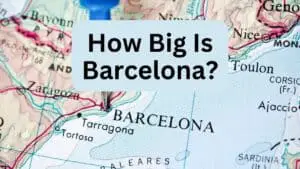If you’re interested in visiting Barcelona or any destination in Spain, you’ve heard of the term siesta and might be curious about it. Some people think it’s a myth, while others say it’s natural, so which is which, you may wonder.
Siesta is a tradition not only in Barcelona but also in the entire country of Spain. In general, Siesta refers to the Midday or afternoon rest, which has become a part of Spanish culture. For this reason, when you visit Barcelona or any Spanish city or town, you’ll notice some establishments close for an hour or more in Midday and reopens in the afternoon.
If you have yet to go to Barcelona (or any Spanish city or town), you may be curious to know more about how Siesta works and what you should know about it. If so, this article is for you.
Here, we’ll cover everything you need to know about Siesta. This information includes a brief history of this tradition, the hours when it happens, and the other valuable details you’ll want to know about this culture.
Without further ado, let’s get into it!

The Origins of Siesta
The custom of taking a nap appears to derive from Islamic Law, despite the term siesta originating in Spain. A particular reference to siestas is found in the Koran.
Nevertheless, siestas have a strong Spanish heritage. Spanish is the language in which the word “siesta” originates. The term comes from the Latin phrase “hora sexto,” which means “sixth hour.”
Many assume “the sixth hour” refers to noontime since it occurs roughly six hours after dawn. So, a siesta is a time of rest or nap during the noon or afternoon.
Over time, siestas have become so popular in Spain for various reasons. Theories range from those that have a direct application to those that are sinister.
In the 1930s, at the height of the Spanish Civil War, siestas were observed for the first time in Spain. According to the hypothesis, siestas were essential due to the economic conditions of the time.
During the Spanish Civil War, most people in Spain were living in poverty. For their families to survive, they had to work multiple jobs simultaneously.
During siestas, people may take time off from work. In most cases, they would work in the morning, take a siesta, and then return to work in the afternoon to work a night shift.
In those days, the majority of people were employed at all times. Therefore, their Siestas allowed them to rest, so they could continue earning money and supporting their families diligently.
It was believed that Spain’s people had too many jobs to take siestas. However, many did so due to the oppressive workplace atmosphere they endured every day.
The Spanish Siesta is believed to have originated when Spanish field workers took breaks during the day to escape the heat. Their daily routine consisted of taking a siesta, a break from the heat, enjoying lunch, and spending time with their families while protected from the harsh weather.
After a short rest, the employees would return to work in the fields later that afternoon. By then, the weather would have cooled down, making operating easier.
It is thought that numerous Spaniards, not just field laborers, adopted this strategy and welcomed siestas. Within a short time, most people were taking a break from their daily stress in the middle of their workday.
Siesta Hours in Barcelona
Since Siesta is part of a tradition that only means a short nap or rest from Midday to afternoon, there’s no exact schedule since you can take a siesta anytime you see fit.
However, most people in Barcelona take a siesta around Midday to late afternoon. In some cases, the small businesses in Barcelona tend to close their shops during this time frame, but the ordinary siesta hours are between 2:00 PM and 4:00 PM.
Now, when you head out to smaller towns and areas within Catalonia, you’ll find Siesta around longer, around 1:00 PM to 5:00 PM.
Business Practices and Siesta in Barcelona
If you’re not used to the idea of Siesta, you may wonder how businesses work in Barcelona with the Siesta tradition.
Although Siesta is part of the culture of the city and the country, only a few people take such. Thus, you can expect small businesses to close during the Midday to early afternoon while large businesses remain operational.
Most restaurants that serve full meals close around 4:00 PM and reopen at 8:00 PM for dinner. During this time, their personnel can rest and prepare for the evening service.
On the other hand, cafes that specialize in hot drinks and nibbles rather than full meals may close at 2:00 PM and reopen at 4:00 PM or 5:00 PM.
As tapas can be enjoyed at any time, it can be assumed that most tapas bars stay open continuously until dinnertime.
Suggesting they reduce their break time during the peak tourist season is never a good idea. In Barcelona, it’s best to embrace their slow-paced culture and customs and not interfere!
If you’re not used to napping during Midday, you’ll appreciate doing much in Barcelona or other towns or cities in Spain.
The Siesta Culture in Barcelona
The siesta culture in Barcelona (and the entire of Spain) is well-known, but it doesn’t mean everyone in the city takes such. Most locals generally take a siesta, especially those working in small businesses and other ordinary workers.
The concept of Siesta is consistent with the Spanish custom of taking a two-hour lunch break, and many people still choose to eat at home and take a brief siesta afterward.
The large department stores and shopping centers in the city’s core of Barcelona do not close for lunch. However, many smaller stores will close two hours between 1:00 PM and 5:00 PM. After all, it is up to each store to determine its operating hours.
Simply put, the weather conditions started the siesta culture in the city. Since many people find it challenging to work under extreme heat, they take it as a break and return to work when the temperature goes down.
However, with the growing modernity, most people are tied up with running businesses that they can’t afford to have a few hours of Siesta. It’s also because international businesses have influenced Barcelona as tourism grew.
Conclusion
So, how does this culture work for you? In general, if your concern is to find the streets of Barcelona empty during siesta hours, you need to be corrected. While most locals tend to take a siesta, a lot of people and businesses remain operational, especially the big ones.
Now, if you’re considering whether you should or shouldn’t take a siesta when in Barcelona, it’s totally up to you. However, we suggest embracing this culture rather than going against it.
Of course, you can stay active from Midday to afternoon, and no one will stop you. However, if you genuinely want to enjoy Spanish culture, taking a short nap after lunch is a pleasant and relaxing thing to do on vacation.



